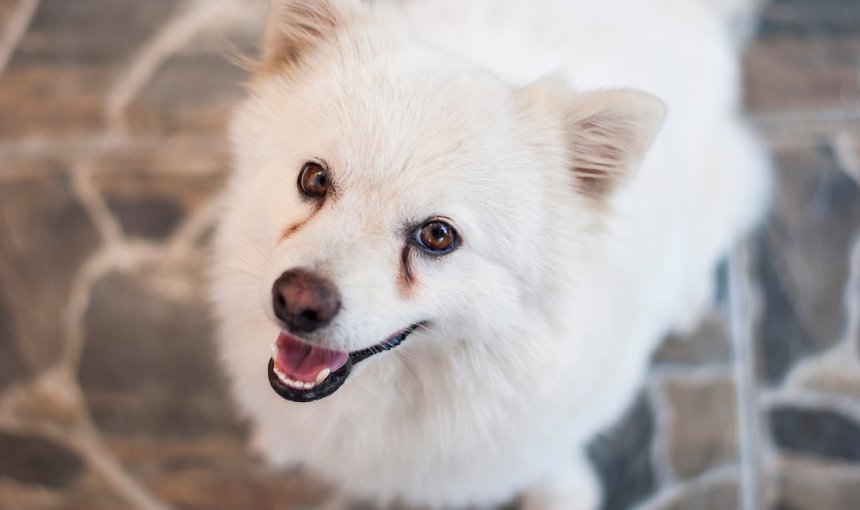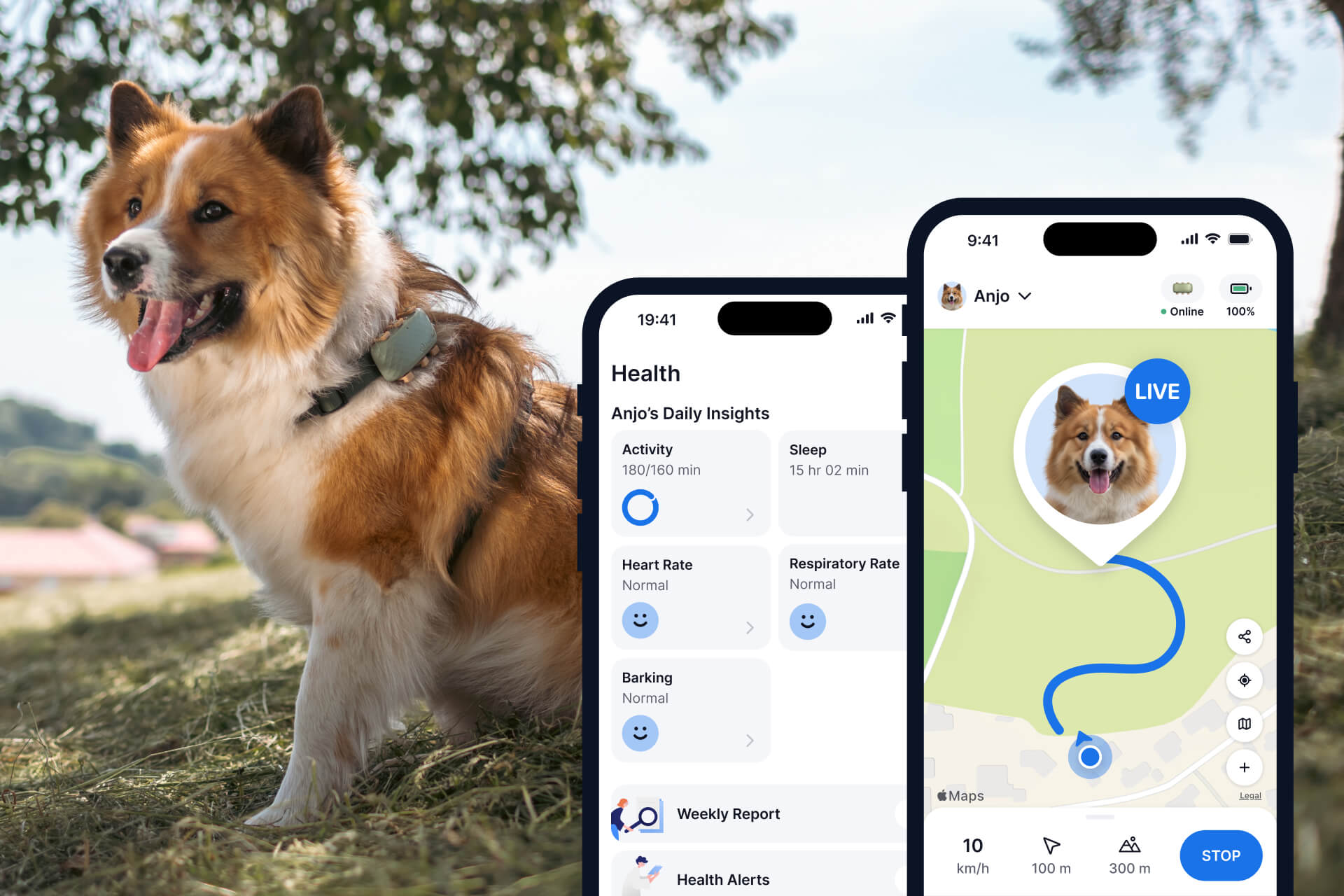 Approved by Dr. Dwight Alleyne, DVM
Approved by Dr. Dwight Alleyne, DVM 7 Causes Of Dog Eye Discharge & How To Handle Them
Much like us, our buddies are also vulnerable to watery eyes, discharge, and even eye boogers for different reasons. But are these a cause for concern or mostly harmless? Here's everything you need to know about eye discharge in dogs - and when to head to a vet.

As spring approaches, you might find your dog ending up with a bad case of watery eyes. Let’s dive right into what can cause dog eye discharge, what an eye infection in dogs looks like – and how tracking if your dog’s wandering into any pollen-riddled areas can help you prevent one in the first place.

Always know your buddy is healthy & safe
Read moreIs dog eye discharge always a cause for concern?
On the bright side, if you’re noticing your dog’s eyes watering more than usual, it’s not always a cause for concern. In fact, tears help clean out our eyes, keep them healthy, and prevent them from getting too dry. But sometimes, they might not drain out from your dog’s eyes 100% – so they might accumulate in the corners of their eyes.
Why does my dog have eye boogers all of a sudden?
If you’re noticing a type of dog eye discharge that just looks a bit like a booger or just a bit…well, goopy – it’s usually pretty normal. In fact, dog eye boogers (much like ours) form because their eyes’ tears accumulate rather than getting drained out through their eye ducts. Plus, this kind of “crusty” material is made up of dried tears, oil, dead cells, and mucus. Which is why it might look slightly reddish-brown in some cases.
You might notice dog eye boogers most commonly in the morning – or after your dog takes a long nap. But while it’s quite normal, watch out for other warning signs, including:
- Red eyes
- Other signs of discomfort, like squinting, or light sensitivity
- Excessive rubbing or pawing at their face
- Other kinds of eye discharge, including white-grey, yellow, or even green mucus
In these cases, you might be dealing with a proper case of dog eye infection. So make sure to drop by your vet immediately.
The main causes of eye discharge in dogs
Now if your dog just seems to be dealing with a bad case of watery eyes – but doesn’t otherwise seem too distressed – it might be wise to give the situation a day or two before heading to your vet. But otherwise, here are the main culprits behind dog eye discharge:
- A foreign object
Which could be pollen, dust, or foreign bodies. In these cases, the wateriness might be due to tears trying to flush them out. - Something else irritating your dog’s eyes
Like a rolled eyelid, since their eyelashes are rubbing directly against the eyeball. (Ouch!) - Blocked nose and eye ducts
Because of this blockage, your dog’s tears don’t drain properly – and lead to excessive tearing and discharge. - Allergies
Dust, mites, pollen, dander, and even common household products (like cleaning fluids) can trigger allergies and watery eyes. - Your dog’s breed
Especially brachycephalic dog breeds, like Bulldogs, Shih Tzus, Pekingese, Boxers, and others.) - Injury
Eye discharge in dogs can also result from injuries – like if a foreign body or liquid gets in their eyes. (Or if they’ve gotten into a fight with another pet or predator.) This can cause irritation and inflammation if left untreated.
💡A dog GPS tracker can help you figure out where your dog tends to spend most of their time throughout the day – so you can understand if they’ve been picking up any pollen from around the neighborhood or getting a sniff of your neighbors’ fertilizer-strewn fields. (And now having a teary fit as a result!)

Follow your dog anywhere
Get real-time location information, wherever they go. And find out when they try to make an escape, or just when they go somewhere they shouldn’t, with Virtual Fences.
Other medical conditions that might cause eye discharge in dogs
Much like humans, dogs can and do end up dealing with eye infections that can cause them discomfort and pain. Some of these diseases are congenital – while others may develop over your dog’s life.
Here are some examples of medical conditions that affect your dog’s eyes:
- Cataracts
Or the clouding of the lens of your dog’s eyes. These can be partial or complete – but both affect your dog’s vision. Cataracts may be congenital or age-related, but may also develop from health conditions like diabetes. - Progressive Retinal Atrophy (PRA)
Which is a genetic condition where the photoreceptors of your dog’s eyes gradually disintegrate. Sadly, this leads to gradual blindness with time. Some dog breeds might be more susceptible to PRA than others. - Corneal ulcers
Or a wound to the cornea of your dog’s eye. This can be caused by an injury, infection, or due to other eye diseases. Watch out for signs like redness and increased blinking. - Conjunctivitis in dogs
Which is one of the more common medical conditions. It may be caused by exposure to harmful chemicals, allergens, or infections. Watch out for redness along with excessive eye discharge. - Dry eyes
Which is a condition in which your dog’s eyes don’t produce enough tears. This can lead to dryness, irritation, and infection. Dry eyes may occur as a result of certain types of medication, genetic factors, or after conjunctivitis. - Glaucoma
Which results from increased intra-ocular pressure. With time, glaucoma can damage your dog’s optic nerves and retina – causing blindness. Symptoms include pain, redness, and increased blinking.
Eye discharge in puppies
Eye discharge in puppies can be normal, especially when they first starting teething – which actually puts some pressure on their tear glands! This leads to increased tear production and watery eyes as a result. Besides, knowing what little balls of energy puppies tend to be, it’s not uncommon for them to get something in their eyes while playing outside or getting watery from the wind.
Just make sure to keep an eye out for other signs of discomfort – like redness, swelling, or foul-smelling discharge. Puppies are quite vulnerable to infections before their vaccinations, so make sure to get them their shots as soon as they’re old enough.
What to expect at your vet
If you’ve gotten your buddy over for a checkup, your vet might begin by thoroughly examining your dog’s eyes – looking for signs of inflammation, injury, or foreign bodies. One of these routine tests is staining your dog’s eyes to determine if there are ulcers present. They might also include a slit lamp examination and ophthalmoscopy to assess the cornea, lens and retina at the back of the eye.
In some cases, your vet might need to conduct a laboratory test to accurately diagnose the cause of your dog’s eye discharge or infection. So they might:
- Take a swab or sample from your dog’s eyes to check for bacterial or viral infections
- Test this sample to determine the cause
- Conduct an allergy test to figure out what’s causing the discharge in the first place
If your dog’s case is especially serious, your vet might need to take an X-ray, ultrasound, or even a magnetic resonance imaging (MRI) scan. This can help them determine if there’s an underlying anatomical abnormality causing the eye discharge.
Treating eye infections in dogs
Treating dog eye discharge depends largely on what’s causing it in the first place. So depending on this, plus how serious it is, your vet might prescribe you:
Medical treatments
If your vet finds that it’s an infection causing the discharge, they might prescribe you an antibiotic ointment to fight it and bring them some relief.
Similarly, if it turns out to be a case of conjunctivitis, your vet might prescribe you anti-inflammatory eye drops or eye ointment. Anti-allergy medication can help in case your dog is sensitive to environmental allergens like pollen.
Eye drops for dogs are another option for treating these conditions or very dry eyes. There are both over-the-counter and prescription options.

Surgical treatments
In some cases, dog eye discharge may occur as a result of anatomical problems or eye diseases that can’t be treated with medication. (Like, for example, eyelid malformations or tumors.)
Which means your vet might recommend surgical treatment instead. Make sure to thoroughly discuss the best course of action with them before taking any decision.
Because in many cases, a successful surgery can help correct the problem and vastly improve your buddy’s health, happiness, and quality of life.
How to prevent eye discharge in dogs: Steps you can take
- Give your surroundings a good cleanup
Pollutants and allergens in your environment can cause excessive tearing and discharge – including cigarette smoke, pollen, or even certain cleaning products. - Give your dog’s eyes a cleanup every so often
Keep your dog’s coat well-groomed around the eyes. Any hair that enters their eyes might cause irritation and tearing. Use a clean, damp cloth or special wet wipes for dogs to remove excess dirt and tears. If you notice a foreign object trapped under your dog’s eyelid (like a hair or a grain of sand), gently pull their eyelids apart slightly to get a good look. And if your dog’s comfortable with it, use a cotton bud to remove it. - Double check your dog’s meals
Make sure you offer them high-quality food that contains all the necessary nutrients. You can also consider supplements specifically designed for eye health. Just make sure to discuss your options with your vet before trying anything new. - Figure out if your dog’s been wandering into any allergy-prone areas
If your dog spends any amount of time outdoors, they could run into pesky pollen or dander from dog parks, woodland near your property, or even your neighbors’ backyards.
In these cases, a dog GPS tracker can actually log these areas for you – so you can check where your dog’s been hanging out most of the day and figure out any allergy-triggering spots in your neighborhood. For example, if you check your dog’s Heat Map & Location History – or track them in real-time with LIVE mode:

Your furry friend’s health and wellbeing means as much as to us as it does to you. So we’ve made it a priority to only share medically-relevant content on our blog. This post was checked, double-checked, and medically verified by Georgia-based vet, Dr. Dwight Alleyne.

Dr. Dwight Alleyne, DVM
Originally from Long Island, New York, Dr. Alleyne began his career at a no-kill animal shelter before becoming a licensed veterinary technician. He graduated from Cornell University Veterinary College in 2006 and completed an internship at Purdue University. Now practicing in Georgia, Dr. Alleyne specializes in soft tissue surgery and ultrasounds. He also writes pet health articles on his website, “The Animal Doctor Blog” (www.anmldrblog.com).



